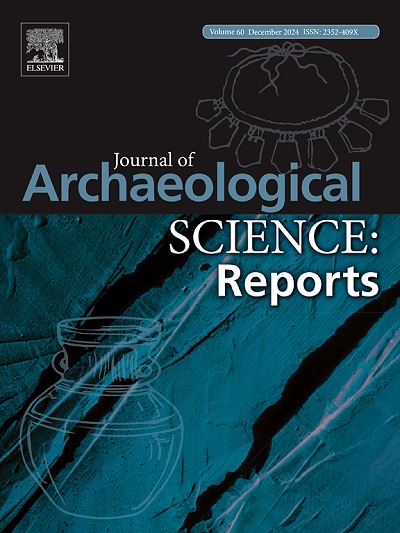Unveiling the origins: Multi-analytical study on the provenance determination of white marble from the ecclesiastical complex of Beati Severi basilica in Classe (Ravenna, Italy)
IF 1.5
2区 历史学
0 ARCHAEOLOGY
引用次数: 0
Abstract
The strategic role of Ravenna (Italy) in the northwestern Adriatic became particularly evident in the early fifth century, when it assumed the role of a sedes imperii and developed into a key center of the Western Roman Empire. This prominence was significantly supported by its seaport Classis, which functioned as one of major hubs for the trade and cultural exchange across the Mediterranean. In the past, the precious marble artefacts in Ravenna and its artistic circuit were described exclusively from stylistic and typological points of view, with no scientific methods employed for determining provenance. This study presents the results of a multi-analytical investigation into fifteen white marble samples, representative of the late antique and early medieval contexts of the ecclesiastical complex of Beati Severi Basilica in Classe. To determine the provenance of the marble, a combination of mineralogical-petrographic techniques (including polarizing, cathodoluminescence and electron microscopy, as well as X-ray powder diffraction) and geochemical methods (stable carbon and oxygen isotope analysis and trace element content via ICP-MS) was employed. The geochemical data were processed using discriminant analysis and compared with reference datasets from known ancient quarries. Most calcitic samples were identified as Proconnesian marble. The remaining calcitic samples were attributed to Aphrodisias, Dokimeion, and Thassos-Aliki (Thassos-2). Two dolomitic samples were attributed to the Cape Vathy/Saliara (Thassos-3), although without statistical evaluation. For the studied marble samples, the most diagnostic factors for provenance determination were a combination of microscopic features (microfabric, grain size, mineral composition, and CL microfacies), carbon and oxygen isotope ratios, and trace element contents – primarily Mn, Sr, Y + REEs, and Pb. Although the combination of the aforementioned methods proved the generally accepted hypothesis that the Ravennate marbles originated from the Proconnesos quarries, it also revealed that these were not the only source. The provenance determinations of marble, imported to Ravenna and Classe in Late Antiquity and reused in the Middle Ages, offers critical insight into the city’s role within Mediterranean trade and cultural networks. It further underscores Ravenna’s orientation towards the Eastern Mediterranean, and its function as a redestribution centre in the broader regional context.
揭开起源的面纱:意大利拉文纳(Ravenna,意大利)班塞(Classe)比蒂塞维里大教堂(Beati Severi basilica)教堂建筑群中白色大理石的来源测定的多重分析研究
拉文纳(意大利)在亚得里亚海西北部的战略作用在五世纪初变得尤为明显,当时它承担了帝国的角色,并发展成为西罗马帝国的重要中心。它的海港Classis是地中海贸易和文化交流的主要枢纽之一,这一突出地位得到了极大的支持。在过去,人们对拉文纳珍贵的大理石工艺品及其艺术线路的描述仅仅是从风格和类型学的角度出发,没有科学的方法来确定其出处。本研究展示了对15个白色大理石样本进行多重分析调查的结果,这些样本代表了贝蒂塞维里大教堂(Beati Severi Basilica in Classe)的古代晚期和中世纪早期背景。为了确定大理石的来源,结合了矿物学-岩石学技术(包括偏光,阴极发光和电子显微镜,以及x射线粉末衍射)和地球化学方法(通过ICP-MS进行稳定碳氧同位素分析和微量元素含量)。利用判别分析对地球化学数据进行处理,并与已知古采石场的参考数据进行对比。大多数方解石样品被鉴定为普罗康尼斯大理岩。剩余的钙质样品归属于Aphrodisias、Dokimeion和Thassos-Aliki (Thassos-2)。两个白云岩样品属于瓦蒂角/萨拉拉(Thassos-3),但没有进行统计评价。对于所研究的大理石样品,确定物源的最重要诊断因素是微观特征(微结构、粒度、矿物组成和CL微相)、碳和氧同位素比率以及微量元素含量(主要是Mn、Sr、Y + REEs和Pb)的组合。虽然上述方法的结合证明了普遍接受的假设,即Ravennate大理石起源于Proconnesos采石场,但它也揭示了这些不是唯一的来源。在古代晚期进口到拉文纳和克拉塞并在中世纪重新使用的大理石的来源确定,为了解城市在地中海贸易和文化网络中的作用提供了重要的见解。它进一步强调拉文纳面向东地中海,以及它在更广泛的区域范围内作为再分配中心的功能。
本文章由计算机程序翻译,如有差异,请以英文原文为准。
求助全文
约1分钟内获得全文
求助全文
来源期刊

Journal of Archaeological Science-Reports
ARCHAEOLOGY-
CiteScore
3.10
自引率
12.50%
发文量
405
期刊介绍:
Journal of Archaeological Science: Reports is aimed at archaeologists and scientists engaged with the application of scientific techniques and methodologies to all areas of archaeology. The journal focuses on the results of the application of scientific methods to archaeological problems and debates. It will provide a forum for reviews and scientific debate of issues in scientific archaeology and their impact in the wider subject. Journal of Archaeological Science: Reports will publish papers of excellent archaeological science, with regional or wider interest. This will include case studies, reviews and short papers where an established scientific technique sheds light on archaeological questions and debates.
 求助内容:
求助内容: 应助结果提醒方式:
应助结果提醒方式:


